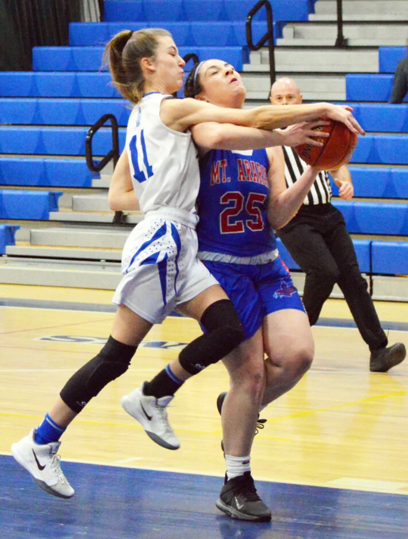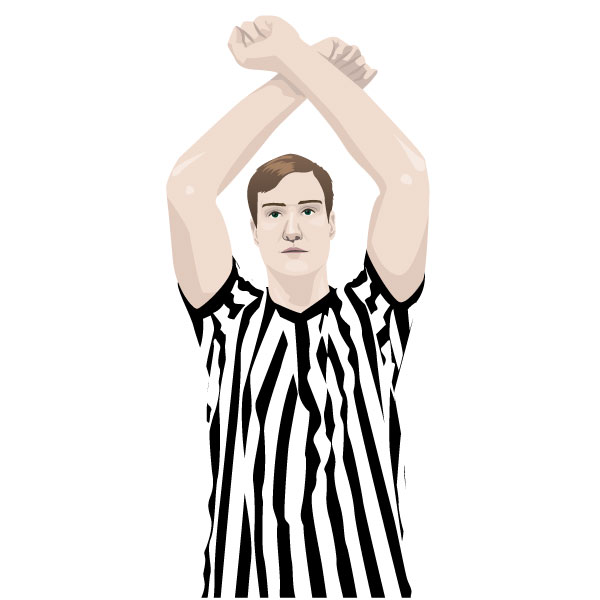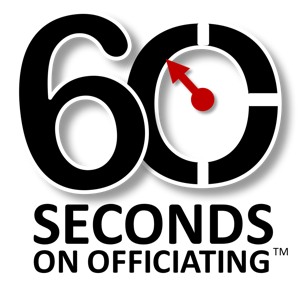
Intentional Proposal: Clarifying Intentional Fouls
Should there be separate signals for intentional fouls and severe fouls? We would like your thoughts on this one.
Separate signals for intentional fouls and severe fouls
A hotly contested game where the near-flawless performance of the officials is keeping the spotlight rightly on the stellar play of both teams is a scenario that unfolds in countless gyms across the country on any given night during the basketball season.
But like in all games, lurking in the shadows is a play and a subsequent ruling that seemingly comes out of nowhere and brings the flow of skilled play to a crashing halt.
For this article, the play we will be dissecting – and offering a possible remedy to reduce confusion and lessen the chance for a volatile reaction – involves a ruling for an intentional foul.
It’s not hard to envision the quick hands of a defender (B-1) pilfering the ball from a dribbler (A-1) near the division line and quickly streaking to the basket, with the pick-pocketed player and new Lead official in hot pursuit.
Both players meet again at their apex about a foot above the ring and the defender’s hustle and skill are rewarded as he blocks the attempted dunk before making body contact with the shooter. They both crash hard to the floor with the echo of the boisterous crowd’s cheers, and the official’s whistle, ringing in their ears.
As the two players slowly gather themselves, the Lead official has his arms crossed in an “X” position above his head ruling the contact as an intentional foul.

And as natural as day following night, the head coach of Team A bellows:
How can that be an intentional foul!? My player blocked the ball!!
And there you have the dilemma – trying to enforce one of the two officiating interpretations from a word that has only one meaning.
Surely, everyone understands the definition of the word, “intentional” to mean, ‘done on purpose; deliberate,” and its synonyms, ‘planned, willful, and premeditated.’
But NFHS Rule 4-19-3 on intentional fouls also includes:
Contact that is hard and/or severe, and is not limited to what is deemed as a deliberate act.
.
There is considerably less protest on intentional foul rulings when a player grabs the jersey or waist of a player to stop a breakaway, or lunges and makes contact on a player near the end of a game with no attempt to play the ball and solely to stop the clock.
But when coaches and spectators of the offending/fouling team (in this example, Team A) see an official rule an intentional foul on what was almost a spectacular defensive play; that is entirely another matter and both parties will undoubtedly register their ill-informed complaint with you.
We believe the experience of officiating is enhanced when clarity reigns and players, coaches and spectators are able to easily understand a rule interpretation.
To that end, we therefore endorse adding a second signal under the intentional foul ruling to clearly delineate player contact that is deemed too physical for safe play.
To make that hard/severe distinction, we propose:
Lowering the crossed arm “X” signal from above the head and bringing it down to just above the waist area.
We believe this new signal would clearly show players, coaches and spectators that the ruling official knows that the contact was not a deliberate and premeditated foul, but rather a defensive play that resulted in contact that could be considered dangerous and too severe for safe play.
And quite often this new specific severe signal will be supported with one or both players writhing in pain on the court.
Please take a moment to voice your opinion in the COMMENT section below about implementing a second signal to clarify the distinction of your intentional foul ruling.

This is a great description of the difference of intentional fouls. Time of the game, the intensity of the foul, and the players involve, this is all part of playing basketball. Does both fouls constitute two free throws and point of interruption? Is this a judgment call by the official?
High School Official 30+ years
State Tournament Boys and Girls Division I & II
College Men & Women Basketball D I-II
Thanks, Lyle, for your feedback…Yes, that is the penalty. We are simply proposing adopting a second signal to clarify if the intentional was in fact deliberate or was it too hard/severe for safe play.
Tim — Ref 60
Yes, the term “severe foul” would be a better category to include in the rule book. I like it. (The parallel in football would be Unnecessary Roughness.)
A defensive player can intentionally tap an arm, barely, to stop the clock if they are behind by 2 points in the final minute, but it isnt severe and can be ruled a legitimate basketball play attempt that reluted in illegal contact. That player could intentionally grab the opponent’s jersey.
Two players bsttling for position at the low post could ‘intentionally’ shove each other, in retaliation to the previous nudge.
The terminology and the signaling of Common, Severe, Intentional, Flagrant should be studied and perhaps updated.
Thanks, Jeff, for weighing in with your valued opinion…
Tim — Ref 60
I was just discussing this with a basketball coach last night.
I asked him for an example of what constitutes an intentional foul.
His response was thus: when a defender makes a non-basketball play such as grabbing an opponent’s jersey in an attempt to impede his movement.
The coach did not know that there could be another scenario (the one described in the above article) that warrants calling an intentional foul.
To answer the author’s question, adding a signal to designate an intentional foul as described in the article is an excellent idea!
Jim, thanks for taking the time to give your feedback on the matter…
Tim — Ref 60
Any thing we can do to better communicate to coaches and spectators is an improvement.
When a player is hit in the head we use an illegal use of hands signal. A secondary hand to the head explains to the coach where the contact occurred but this is not an nfhs approved signal There are a few secondary signals that would help clarify what truly happened.
Anytime we can more clearly communicate what happened reduces the chance of argument, gesturing and tempers flaring.
Be proactive and let’s introduce a few more communication signals.
Gregg Becker
Greg, we are on the same page…Thanks for your feedback.
Tim — Ref 60
I believe the signal for an intentional foul should remain the same. If the rules are followed, I do not believe we, as officials, should begin adjusting mechanics merely to help others understand the rule. When the coach asks the question in the above example, we should reply by rule the foul is intentional due to the excessive physical contact. It does not have to be deliberate.
John, thanks for taking the time to offer your opinion…
“This thing of ours,” — officiating — is a steady stream of decisions to blow or not blow our whistles, and both quite often are considered wrong by half of the people in the gym. We believe anything we can do to lighten that refereeing burden is a good thing. Especially when the ruling administration is unchanged.
Tim — Ref 60
NFHS rules definition for intentional foul is a personal or technical foul that may or may not be premeditated and is not based solely on the severity of the act. Intentional fouls include, but are not limited to:
a. Contact that neutralizes an opponent’s obvious advantageous position.
c. Contact away from the ball with an opponent who is clearly not involved with a play.
d. Contact that is not a legitimate attempt to play the ball/player specifically designed to stop the clock or keep it from starting.
e. Excessive contact with an opponent while the ball is live or until an airborne shooter returns to the floor.
Tim
Great idea! That play happened to me earlier this season. Coach was adamant that it was an attempt to block the shot, therefore NOT intentional! I explained the hard foul ruling but he kept complaining the “intentional “ ruling. This additional signal will surely help!!
Thanks for your opinion, Mike…I know first-hand that you handled the situation masterfully!
Tim — Ref 60
I have offered this to IAABO International as a signal change on more than one occasion and have been ignored. I may try it again at the end of this season. My local board uses this signal unofficially, but it’s only the older veterans that use it as we learned this three interpreters ago.
Thanks, William, for your feedback…Let’s see if we can move this proposal forward…
Tim — Ref 60
I agree with the suggestion of calling it a “severe foul” or something similar to make a distinction between what most people think of as an intentional foul and a hustling play on the ball that results in hard/rough contact, as described in the article. I think having a separate name and separate signal will preempt lots of arguments from coaches about how an “intentional” foul is interpreted.
Thanks, Sue, for your feedback…we wholeheartedly agree…
Tim — Ref 60
To me, the play Tim describes is not an intentional foul. He seems to make the point that since the block occurred above the rim that it had some bearing on the decision. What if the same play was between two 5’10” point guards at considerable less elevation? Yes, these big fellas had a longer distance to travel downward but does that qualify as intentional? It was a basketball play. Maybe I’m missing the point that this is strictly a mechanics food for thought question.
Greg, thanks for sharing your opinion…I believe the “second signal” proposal would still benefit officials, no matter what the height, age or skill level of the players…The ability to offer both a preliminary and table signal that the contact on a particular play was too hard/severe for safe play would be an easy way to diffuse a potentially volatile situation…
If we are going to add signals for clarification then in my opinion both the intentional and the severe foul should be preliminary signals for the act IE a push – However before adding something like this then there needs to be a clear difference in the penalty for the two separate fouls.
John, thanks for your feedback…I agree with the your point on the importance of giving this second signal at the spot of the foul, but don’t think there needs a distinction on the penalty portion…The intent of the proposal is to eliminate any volatility at the moment the foul is called…
Good idea. I think the x in the lower position is a less intimidating expression by the official. Not so much in your face.
Agreed, David…Thanks for your feedback…
Tim — Ref 60
While the attempt to clarify the rule is a step in the right direction, we should look at all levels of play. Unfortunately, many officials at the lower levels do not/will not use proper signals. The proposed signal is unknowingly used all the time as a “illegal use of hands /hit/hack. Most never use the signal in the manuel but use a lazy variation similar to the proposed signal, thus causing more confusion. Also most coaches at the lower levels don’t know the rules and this would enhance the differences created by their lack of knowledge of the rules.
Ron, thanks for your feedback…
Tim — Ref 60
FIBA has clearly defined five infractions that constitute an “intentional” foul which it calls unsporting. The penalty is two free throws and possession and a possibility of disqualification where deemed appropriate. All situations reference plays where there is no attempt to play legitimately.
A. A hard foul
B. Interference with a transition play
C. No attempt to play the ball eg. shirt pull
D. Clear path situation
E. Attempt by the defence to delay play on an inbound pass in the last two minutes.
These have significantly reduced the occurrences of intentional fouls in my experience.
Bob, thanks for the feedback…
Tim — Ref 60
Isn’t this the NCAA-M “Excessive Contact” signal? In men’s college games, an official can use that signal to clarify his call after signalling a Flagrant 1 (or Flagrant 2) foul.
Thanks, Ilya, for your feedback…It is not, insofar as the NCAA-M material that I have seen…
Tim — Ref 60
I agree. The portion of the rule on intentional fouls is almost never even known by the crowd, a lack of awareness that is surprisingly shared by too many coaches. This new signal would highlight that portion of the rule, and has the potential to go a long way towards defusing a volatile situation.
We agree, Bob…Thanks for your feedback…
Tim — Ref 60
I love the idea of having an added signal to communicate clearly with players/coaches/spectators.
Here is where it might prove difficult. IMO, the signal needs to be something that doesn’t reflect the original signal of the “X” arms above the head. Providing the same signal at a lower level of the body isn’t going to change the thought process/argument factor. There would need to be a distinct and clear signal to communicate the distinction between the two. This will surely cut back on any push back from players/coaches/spectators.
Again, I love the idea and am completely in favor of an additional signal for us to use in our “tool box.”
Respectfully,
AJ
I wouldn’t want NFHS to use the ncaa’s Flagrant 1 or 2 names, but I agree that the word “Intentional” isnt accurate in some of the situations others have desribed here. It would be better — for coaches and players, for fans, and for officials — if the Rules provided two categories: Intentional (( not based on whether the illegal act was premeditated, as the current rule describes )) and “Extreme” or “Unnecessary” or Severe” or a similar title (( not intentional as people might interpret that, but definitely ‘too much’ and worthy of 2 FTs plus the possession )).
Describe the two categories with distinct and descriptive labels, then provide a separate signal for each. (I hope the Rules Committee checks in on this discussion board, and/or advocates for improvement feed this into the system.)
Btw, this dilemma isnt new. In response to this chat, i searched and found a similar 60 SECONDS discussion back in January ref60.com/2014/01/intentional-fouls/
AJ, thanks for your feedback…I’m not sure it needs to be a completely different signal, but we agree we need a signal to differentiate between premediated fouls and those fouls that are not purposeful but are too excessive/severe/hard for fair, safe play…
Tim — Ref 60